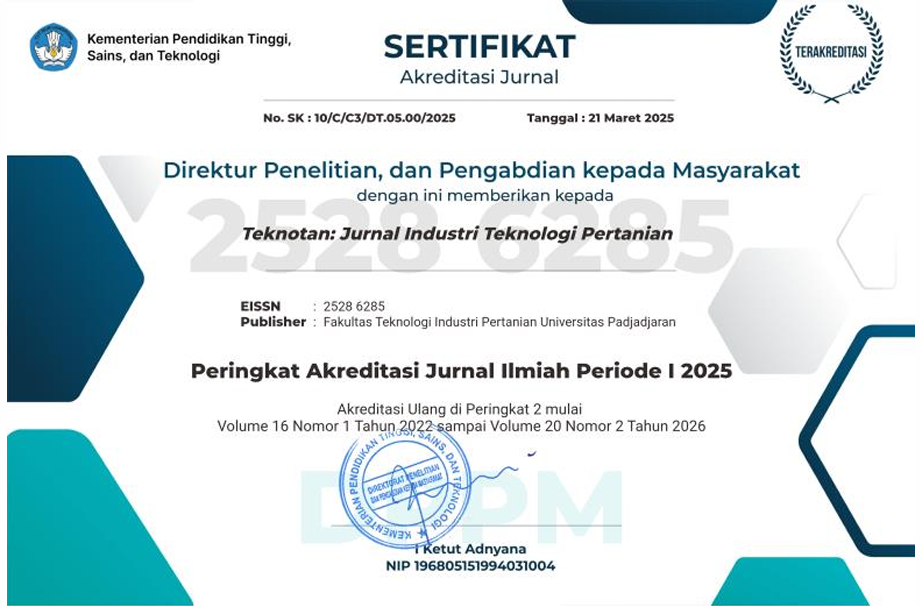Optimization of Maltodextrin Production from Pineapple Stem Waste Using Response Surface Methodology
Abstract
The enzymatic hydrolysis of starch from pineapple stem waste for maltodextrin production was successfully optimized using Response Surface Methodology (RSM). The study identified enzyme concentration and hydrolysis time as critical factors significantly influencing reducing sugar concentration and DE values. Under the optimal conditions (16 µL enzyme/30 gram of dry starch and 30 minutes hydrolysis time), the model predicted a reducing sugar concentration of 13.9%. However, the experimental validation produced an actual yield of 13.21%. The model RSM demonstrated a reliability level of 95.05% (moderately accurate), with deviations primarily due to experimental variability and model limitations. ANOVA analysis confirmed the model's validity with an R² value of 0.9873, while residual analyses supported its adequacy and predictive accuracy. The 3D surface response analysis highlighted the critical thresholds for optimizing reducing sugar production. This study provides a sustainable solution for valorizing pineapple stem waste into industrially valuable maltodextrin, supporting environmental conservation and the circular economy. Further studies are recommended to investigate the impact of enzyme characteristics, substrate pretreatment methods, and large-scale process validation to enhance the efficiency and commercial viability of maltodextrin production from pineapple stem waste.
Keywords
Full Text:
PDFReferences
Bhatt, Pankaj, Vipin Kumar, Suruchi Singh, Sakshi Garg, Mukesh Kumar, Wong Ling Shing, Vinoth Kumarasamy, Shilpa Pahwa, and Vetriselvan Subramaniyan. 2025. “Enzymatic Debranching of Starch: Techniques for Improving Drug Delivery and Industrial Applications.” Starch - Stärke, March. https://doi.org/10.1002/star.202400224.
Cabeza, Camila, Amal El Gohary Ahmed, Mario Minauf, Karin Wieland, and Michael Harasek. 2025. “Starch Hydrolysates, Their Impurities and the Role of Membrane-Based Technologies as a Promising Sustainable Purification Method at Industrial Scale.” Food Research International, 116300. https://doi.org/https://doi.org/10.1016/j.foodres.2025.116300.
Cai, Cheng, Chaofeng Zhang, Ning Li, Huifang Liu, Jun Xie, Hongming Lou, Xuejun Pan, J Y Zhu, and Feng Wang. 2023. “Changing the Role of Lignin in Enzymatic Hydrolysis for a Sustainable and Efficient Sugar Platform.” Renewable and Sustainable Energy Reviews 183:113445. https://doi.org/https://doi.org/10.1016/j.rser.2023.113445.
Chen, Junfan, Desheng Liu, Bo Shi, Hai Wang, Yongqiang Cheng, and Wenjing Zhang. 2013. “Optimization of Hydrolysis Conditions for the Production of Glucomanno-Oligosaccharides from Konjac Using β-Mannanase by Response Surface Methodology.” Carbohydrate Polymers 93 (1): 81–88. https://doi.org/https://doi.org/10.1016/j.carbpol.2012.05.037.
Chu, Pei Hsia, Mohd Azwan Jenol, Lai Yee Phang, Mohamad Faizal Ibrahim, Sehanat Prasongsuk, Wichanee Bankeeree, Hunsa Punnapayak, Pongtharin Lotrakul, and Suraini Abd-Aziz. 2021. “Starch Extracted from Pineapple (Ananas Comosus) Plant Stem as a Source for Amino Acids Production.” Chemical and Biological Technologies in Agriculture 8 (1): 1–15. https://doi.org/10.1186/s40538-021-00227-6.
Collares, Renata M, Luiza V S Miklasevicius, Mariana M Bassaco, Nina P G Salau, Marcio A Mazutti, Dilson A Bisognin, and Lisiane M Terra. 2012. “Optimization of Enzymatic Hydrolysis of Cassava to Obtain Fermentable Sugars.” Journal of Zhejiang University. Science. B 13 (7): 579–86. https://doi.org/10.1631/jzus.B1100297.
Do, Ha Viet, Anh Thuy Vu, and Phuong Thanh Nguyen. 2024. “Effects of Partial Precipitation and Freeze-Drying on Morphology and Physicochemical Properties of Rice Starch Hydrolysates.” The Journal of Agriculture and Development 23 (Special Issues 1 SE-): 196–204. https://doi.org/10.52997/jad.SI1.17.2024.
Joyjamras, Keerati, Chatchai Chaotham, and Pithi Chanvorachote. 2022. “Response Surface Optimization of Enzymatic Hydrolysis and ROS Scavenging Activity of Silk Sericin Hydrolysates.” Pharmaceutical Biology 60 (1): 308–18. https://doi.org/10.1080/13880209.2022.2032208.
Kunamneni, Adinarayana, and Suren Singh. 2005. “Response Surface Optimization of Enzymatic Hydrolysis of Maize Starch for Higher Glucose Production.” Biochemical Engineering Journal 27 (2): 179–90. https://doi.org/https://doi.org/10.1016/j.bej.2005.08.027.
Luis, José, JOSE LUIS SOTO, Luis García, José González, Aurea Bernardino-Nicanor, and Leopoldo González-Cruz. 2012. “Influence of Starch Source in the Required Hydrolysis Time for the Production of Maltodextrins with Different Dextrose Equivalent.” African Journal of Biotechnology 11 (August):13428–35. https://doi.org/10.5897/AJB12.2257.
Lv, Xiaowen, Lei Wu, Jing Wang, Junguo Li, and Yuchang Qin. 2011. “Characterization of Water Binding and Dehydration in Gelatinized Starch.” Journal of Agricultural and Food Chemistry 59 (1): 256–62. https://doi.org/10.1021/jf103523u.
Marchal, Leon. 2008. “Partial Enzymatic Hydrolysis of Starch to Maltodextrins on the Laboratory Scale.” In Carbohydrate Biotechnology Protocols 10 (1999), 119–27. https://doi.org/10.1007/978-1-59259-261-6_10.
Mardawati, Efri, Parlan, Tita Rialita, and Bambang Nurhadi. 2018. “Optimization of Moistening Solution Concentration on Xylanase Activity in Solid State Fermentation from Oil Palm Empty Fruit Bunches.” IOP Conference Series: Earth and Environmental Science 141 (1): 12018. https://doi.org/10.1088/1755-1315/141/1/012018.
Moore, Geovana Rocha Plácido, Luciana Rodrigues do Canto, Edna Regina Amante, and Valdir Soldi. 2005. “Cassava and Corn Starch in Maltodextrin Production.” Química Nova. scielo .
Nath, Pinku Chandra, Amiya Ojha, Shubhankar Debnath, Kumari Neetu, Sayan Bardhan, Priya Mitra, Minaxi Sharma, Kandi Sridhar, and Prakash Kumar Nayak. 2023. “Recent Advances in Valorization of Pineapple (Ananas Comosus) Processing Waste and by-Products: A Step towards Circular Bioeconomy.” Trends in Food Science & Technology 136:100–111. https://doi.org/https://doi.org/10.1016/j.tifs.2023.04.008.
Novia, Novia, Elda Melwita, Asyeni Miftahul Jannah, Selpiana Selpiana, Yandriani Yandriani, Bazlina Dawami Afrah, and Muhammad Rendana. 2025. “Current Advances in Bioethanol Synthesis from Lignocellulosic Biomass: Sustainable Methods, Technological Developments, and Challenges.” Journal of Umm Al-Qura University for Applied Sciences. https://doi.org/10.1007/s43994-025-00212-x.
Nurhadi, Bambang, Parlan M T P, Annisa Ermawar Riksfardini, Sondari Dewi, Md Sikin Adi, Mahani, Indiarto Rossi, et al. 2025. “Upcycling Pineapple Biomass Waste to Produce Maltodextrin through Enzymatic Hydrolysis.” International Journal of Food Properties 28 (1): 2463519. https://doi.org/10.1080/10942912.2025.2463519.
Ospankulova, G., V. Litvyak, S. Saduakhasova, B. Bulashev, A. Bokterbaeva, and Y. Yermekov. 2020. “Physicochemical Properties of Maltodextrins from Wheat and Corn Starch.” Procedia Environmental Science, Engineering and Management 7 (4): 539–49.
Sadeghi, Alireza, Fakhri Shahidi, Seyed Mortazavi, and Mehdi Nassiri-Mahallati. 2008. “Evaluation of Different Parameters Effect on Maltodextrin Production by α-Amylase Termamyl 2-X.” World Appliance Sciences Journal 3 (January).
Sasaki, Tomoko, and Kaoru Kohyama. 2012. “Influence of Non-Starch Polysaccharides on the in Vitro Digestibility and Viscosity of Starch Suspensions.” Food Chemistry 133 (August):1420–1426. https://doi.org/10.1016/j.foodchem.2012.02.029.
Sigüenza-Andrés, Teresa, Valentín Pando, Manuel Gómez, and José M Rodríguez-Nogales. 2022. “Optimization of a Simultaneous Enzymatic Hydrolysis to Obtain a High-Glucose Slurry from Bread Waste.” Foods (Basel, Switzerland) 11 (12). https://doi.org/10.3390/foods11121793.
Sitio, Septi Enjelina, Fitri Dwi Nurlaili, Muhammad Zaki Riadhus Shalihin, Rizka Amalia, and Vita Paramita. 2024. “Optimization of Sorghum Starch (Sorghum Bicolor L.) Partial Hydrolysis Using Microwave-Assisted Acetic Acid Catalyst.” AgriTECH 44 (2): 173. https://doi.org/10.22146/agritech.83457.
Vasić, Katja, Željko Knez, and Maja Leitgeb. 2021. “Bioethanol Production by Enzymatic Hydrolysis from Different Lignocellulosic Sources.” Molecules (Basel, Switzerland) 26 (3). https://doi.org/10.3390/molecules26030753.
Veen, M E Van der, S Veelaert, A J Van der Goot, and R M Boom. 2006. “Starch Hydrolysis under Low Water Conditions: A Conceptual Process Design.” Journal of Food Engineering 75 (2): 178–86. https://doi.org/https://doi.org/10.1016/j.jfoodeng.2005.04.006.
Veza, Ibham, Martin Spraggon, I M Rizwanul Fattah, and Muhammad Idris. 2023. “Response Surface Methodology (RSM) for Optimizing Engine Performance and Emissions Fueled with Biofuel: Review of RSM for Sustainability Energy Transition.” Results in Engineering 18:101213. https://doi.org/https://doi.org/10.1016/j.rineng.2023.101213.
Wang, Yanhua, Chen Chao, Hongjie Huang, Shaokang Wang, Shuo Wang, Shujun Wang, and Les Copeland. 2019. “Revisiting Mechanisms Underlying Digestion of Starches.” Journal of Agricultural and Food Chemistry 67 (29): 8212–26. https://doi.org/10.1021/acs.jafc.9b02615.
Xu, Fen, Liang Zhang, Wei Liu, Qiannan Liu, Feng Wang, Hong Zhang, Honghai Hu, and Christophe Blecker. 2021. “Physicochemical and Structural Characterization of Potato Starch with Different Degrees of Gelatinization.” Foods. https://doi.org/10.3390/foods10051104.
Yolmeh, Mahmoud, and Seid Jafari. 2017. “Applications of Response Surface Methodology in the Food Industry Processes.” Food and Bioprocess Technology 10 (March). https://doi.org/10.1007/s11947-016-1855-2.
Zhao, Yuanyuan, Yunbo Sun, Zhiyun Meng, Jinnan Guo, Guanqun Peng, Wenzhong Sun, Xiaoxia Zhu, et al. 2023. “Effects of Enzymatic Treatments on Different Crystal Types of Starch.” Food Chemistry Advances 3:100334. https://doi.org/https://doi.org/10.1016/j.focha.2023.100334.
DOI: https://doi.org/10.24198/jt.vol19n1.10
Refbacks
- There are currently no refbacks.
Indexed by:

This work is licensed under a Creative Commons Attribution 4.0 International License (CC BY-SA 4.0)


1.png)
.png)







